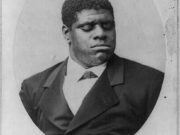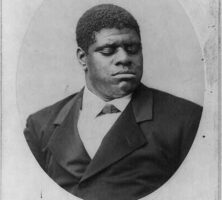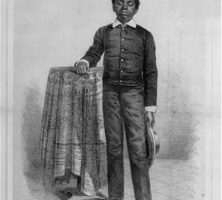One of the most famous American entertainers of the nineteenth century, Thomas “Blind Tom” Wiggins was an African American musician and composer. Blind from birth and born into slavery, Wiggins became well known for his piano virtuosity. Though undiagnosed at the time, it is likely that he was autistic as well.
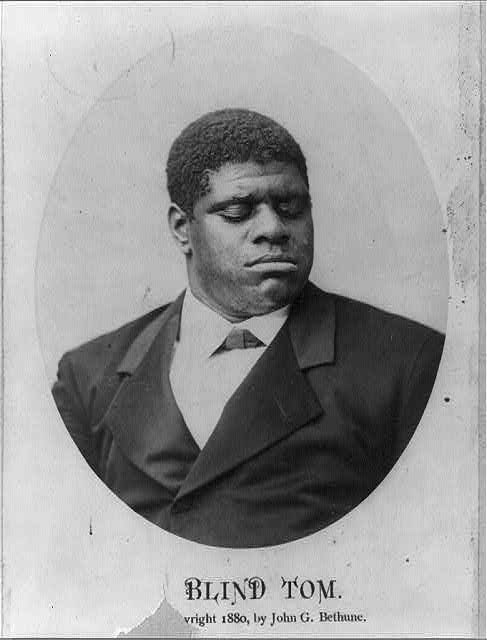
Thomas Greene Wiggins was born near Columbus on May 25, 1849, to Charity and Domingo Wiggins, a couple who were enslaved by Wiley Jones. After discovering that the infant was blind, Jones refused to feed or clothe him. Wiggins’s mother interceded to save his life, and several months later Wiggins, his two older siblings, and his parents were sold at auction to General James Bethune, a Columbus lawyer. The Bethune family had seven musically gifted children who played piano or sang, and Wiggins stood by, rapt, as the children practiced. Soon, he began reproducing the music he heard on the keyboard, and Bethune realized that this young enslaved boy was a musical prodigy. Piano lessons were provided for him, and Wiggins’s ability quickly surpassed that of his teachers. Bethune recognized his talent as a potential source of income, and Wiggins was hired out at the age of nine or ten to a traveling showman named Perry Oliver. Wiggins’s demanding tour schedule often included four performances a day, and as he grew into a large man, his graceful precision stunned audiences.
From his earliest years “Blind Tom,” as he became known, could mimic many kinds of sounds, from birdcalls to trains, with unbridled and uninhibited enthusiasm. In time he would incorporate such effects into his musical works, imitating wind and rain, for example, and claiming that the sounds of nature had taught him the melodies. Blind Tom became so renowned that U.S. president James Buchanan invited him to Washington, D.C., and he became the first African American musician to perform at the White House. On one tour, he crossed paths with the writer Mark Twain, who was himself on a speaking tour. Twain was so enthralled with Wiggins’s remarkable abilities that he attended three performances in a row in 1869.
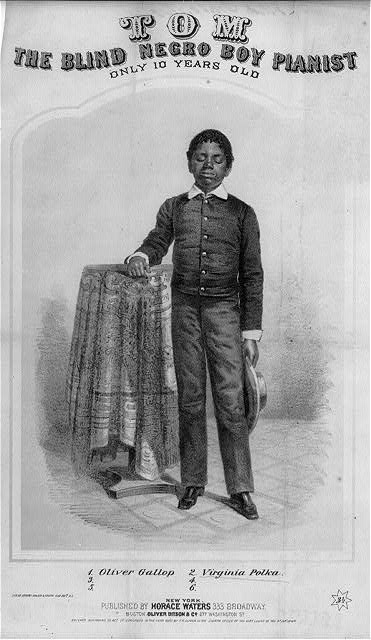
Blind Tom’s performances invariably contained a challenge, in which an audience member was brought onstage to play the most difficult piece of music he or she could. Blind Tom would stand by, wringing his hands and making improbable one-footed leaps in the air, anticipating the challenge, and naming each note as it was played. He then retook the piano and played the piece back exactly as he had heard it, flaws and all. He could also play different pieces of music with each hand while singing a third, all in different keys.
In 1861 Blind Tom was on tour in New York when Georgia seceded from the Union. He and his manager returned south, and his manager scheduled a number of events that would raise money for the Confederate cause. Inspired by what he heard of the war, the fifteen-year-old Wiggins composed his most famous piece, “The Battle of Manassas,” a song evoking the sounds of battle interspersed with train sounds and whistles, which Wiggins made himself. One biographer wrote that Blind Tom’s “perfect pitch, hypersensitive clarity, elastic vocal chords, lack of inhibition and total immersion in the world of sound enabled him to re-create a 'harum-scarum’ battlefield like no other.” Many of the proceeds from his concerts during this period went to help sick and wounded Confederate soldiers.
Wiggins’s lack of emotional development coupled with extraordinary musical ability made him prime for exploitation. After the Civil War (1861-65) Bethune’s son, John, took over the management of Blind Tom, and he used Wiggins’s considerable income to support his own extravagant lifestyle. This continued guardianship of Blind Tom by the Bethune family following emancipation caused some to refer to Wiggins as “the last slave.” For a number of years John Bethune and Blind Tom toured the United States together. Bethune hired a manager to tour with Wiggins during the seasons he was unavailable, but Bethune continued to tour on and off with Wiggins until Bethune’s death in 1884. A series of messy court cases transferred the care of Blind Tom to Bethune’s estranged wife, Eliza, in 1887. In an effort to take control of Wiggins’s income, Eliza Bethune persuaded his mother to officially sign over all of his rights to her, and Wiggins moved with Bethune when she relocated to New York. For several years Charity Wiggins also lived with her son in Bethune’s New York home.
Blind Tom’s final years were spent holed up in Eliza Bethune’s house in Hoboken, New Jersey, which had been purchased with Wiggins’s earnings. He died of a stroke on June 13, 1908, at the age of fifty-nine. There is considerable debate, however, about his burial site. Initially he was interred in the Evergreens Cemetery in Brooklyn, New York, though some argued at the time that the body buried there was not Blind Tom’s. Others believe that Wiggins was initially buried there but was later exhumed and reinterred near his birthplace in Columbus. Today, two plaques, one in Brooklyn and another in Columbus, mark the possible resting places of Blind Tom.
Blind Tom’s story became the subject of great interest around the turn of the twenty-first century. Articles about him have appeared in such periodicals as the New Yorker and the Oxford American, and in 1999 pianist John Davis made a new recording of fourteen of Blind Tom’s original pieces. In 2002 the 7 Stages Theatre in Atlanta produced a play based on Wiggins’s life entitled Hush: Composing Blind Tom Wiggins. Columbus State University holds a small collection of Blind Tom’s original sheet music.


